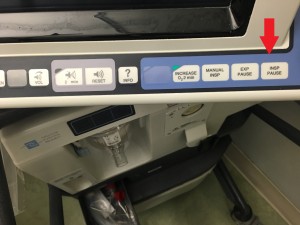You are working resus at 3 am when you hear an alarming vent. It’s the patient in room “E” who is intubated and has been admitted for 36 hours waiting for a stepdown bed. The patient is satting 99% and you are tempted to just hit the silent button and walk away since this patient has been signed out a million times and you know nothing about them. But being the excellent resident you are, you decide to investigate. You notice the machine is showing a “high PIP” alarm. You know “PIP” means peak inspiratory pressure but your fund of knowledge is depleted beyond this.
Ventilator alarms are important to investigate, never ignore them! Ignoring a ventilator alarm can easily kill your patient. We should know how to investigate these alarms and also know when to call for help from respiratory therapy and our attendings.
The most common alarm you will encounter is an elevated “Peak Inspiratory Pressure” or PIP. Since most patients in the emergency department are vented in volume assist control, the following is in reference to this mode. The machine is trying to tell you that it is having to use higher pressure than normal to deliver the requested tidal volume to the patient. An elevated PIP can be concerning for the following reasons:
- Although PIP is not exactly the pressure the alveoli is receiving, if severely elevated there may be elevated pressure in the lungs that can lead to barotrauma, pneumothorax or increased thoracic pressure which will have hemodynamic consequences
- Machines are set to stop delivering breaths if the PIP is severely elevated; the machine will stop the inspiratory process to prevent barotrauma but this may lead to delivering only small, insufficient tidal volumes
The most common cause of elevated PIP in the emergency department is an insufficiently sedated patient. If the patient has dysynchrony with the ventilator and is trying to exhale, cough or bite the tube while the machine is delivering a breath, the peak inspiratory force will become higher. So, the first step is to look at the patient and determine if they are fighting against the tube or look to be in discomfort. If so, sedate them more (ultimately in the ICU this may lead to chemical paralysis).
Next if possible perform an inspiratory hold maneuver and check the plateau pressure. If your plateau pressure is < 30, you do not have to be concerned for barotrauma. If > 30, you need to decrease your tidal volumes and PEEP to prevent barotrauma.
The next easy step is to disconnect the patient from the ventilator and bag them.
- If the patient requires a lot of force to bag then investigate the following:
- The ETT may be obstructed by secretions, so attempt in-line suction
- The ETT may be kinked
- If the patient has a hx of obstructive pulmonary disease they may be in bronchospasm, in which case give nebs
- The tube may be lodged in a bronchus (evaluate with an xray)
- If the patient is easy to bag the problem exists on the ventilator and tubing side:
- Evaluate for secretions/water in the tubing
- Evaluate for water/condensation in the filter
- Recheck your ventilator settings, involve respiratory to try a different ventilator

